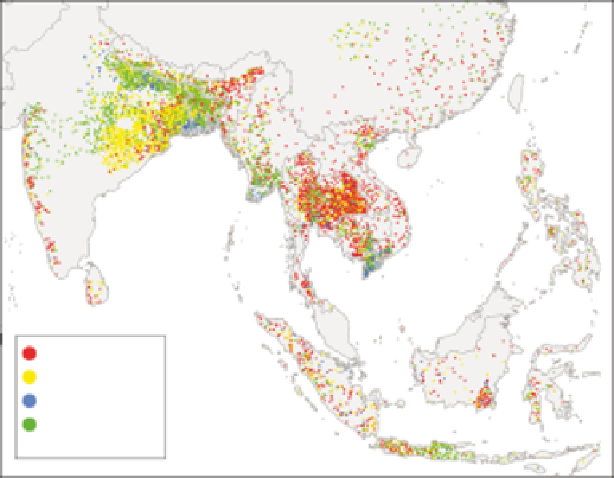Biology Reference
In-Depth Information
Nepal
India
Bangladesh
Laos
Burma
Vietnam
Thailand
Cambodia
Malaysia
very poor soil
poor soil
problem soil
good soil
each dot = 5000 ha
Indonesia
Fig. 5.1.
Soil quality in rain-fed lowland rice systems.
Soils in rain-fed (intermediate
and shallow) rice systems in Asia are often constrained by abiotic stresses and nutrient
deficiency (Haefele and Hijmans 2007; Haefele and Hijmans 2009). Note: Rain-fed upland
rice areas are not included in this map. For a color version of this figure, please refer to the
color plate.
Thailand, but also for parts of India (MacDonald
et al. 2011; Rose et al. 2010). Soils with high P
retention potential are widespread in Southeast
Asia, as well as in Africa and South America
(Batjes et al. 2011). Unless high doses of P fertil-
izer are applied or other measures, such as liming
on acidic soils, are taken to reduce P retention,
plant-available P is low on such soils, leading
to P deficiency and reduced yield. In addition
to P fixation, some of the major rice-growing
regions coincide with areas of poor and problem
soils (Figure 5.1; Table 5.1) where P deficiency is
widespread but may not be the only factor limit-
ing plant growth (Haefele and Hijmans 2007 and
2009; Kirk 2004).
Obviously, the degree of P deficit (or surplus)
depends on the amount of P fertilizer applied per
field; however, several additional factors related
to soil properties and agronomic practices, most
importantly water management, strongly affect
plant P status. Generally, P deficiency is most
common in rain-fed rice systems (Table 5.1) and
least common in irrigated rice systems. The fac-
tors that affect P availability across the main rice
systems can be summarized as follows:
I. Irrigated rice systems and favorable rain-fed
lowlands:
Soil water saturation offers optimal con-
ditions for P movement (diffusion) in soil
and therefore typically provides more P for
uptake by the root (Huguenin-Elie et al.
2009);
Alterations in soil chemistry after flood-
ing enhance P solubility as a result of
reductive processes and rhizosphere acid-
ification (Huguenin-Elie et al. 2009; Kirk
2004);
A reliable water supply enhances not only
yield but also yield predictability; this in
turn leads farmers to increase investments
in agrochemicals, such as P fertilizer. Irri-
gated and favorable lowland fields are
therefore more likely to be well fertilized;
Higher yields, on the other hand, result in
higher rates of P removal with harvested

Search WWH ::

Custom Search